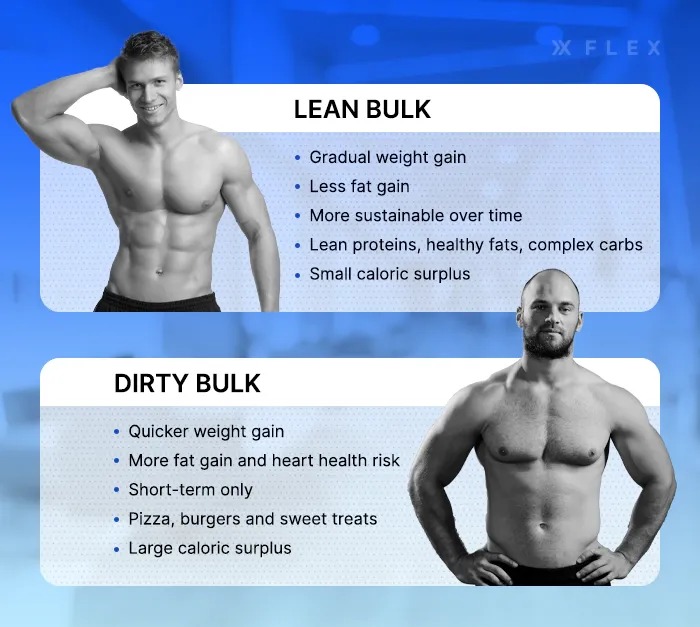La prise de masse est une stratégie utilisée par les personnes qui souhaitent augmenter la taille et la force musculaires en mangeant plus de calories qu’elles n’en brûlent. Il existe deux approches principales :
- Dirty Bulk: Eat a lot of calories—even if they come from less nutritious foods—to gain weight fast.
- Clean Bulk: Eat a controlled surplus of calories from mostly whole, nutritious foods to build muscle with minimal fat gain.
Qu’est-ce que la prise de masse ?
La prise de masse consiste à mettre votre corps dans un état de Surplus calorique– manger plus de calories que vous n’en brûlez – pour fournir de l’énergie pour la croissance musculaire.

Points clés :
- Essential for muscle growth at advanced training levels.
- Both methods result in increased muscle and some fat gain.
Pourquoi les amateurs de gym prennent-ils du volume ?
La prise de masse vous aide à :
- Build new muscle fibers.
- Support increased training intensity.
- Overcome the body’s higher energy demands as you work out harder.
Le rôle des protéines
Les protéines fournissent les éléments constitutifs (acides aminés) nécessaires à la réparation et à la croissance musculaires. Une recommandation courante est de manger au moins 0,6 gramme de protéines par livre de poids corporel. Le choix de protéines complètes (qui contiennent tous les acides aminés essentiels) est essentiel.
Qu’est-ce que la prise de masse sale ?
La prise de masse sale se concentre sur la consommation d’un un grand nombre de calories pour maximiser les gains musculaires rapidement, souvent avec moins d’attention à la qualité nutritionnelle des aliments.
Avantages:
- Quick Weight Gain: Maximizes muscle protein synthesis quickly.
- Convenience: No need to meticulously count calories.
- Effective for Underweight Individuals: Rapid overall weight gain can be beneficial.
Inconvénients:
- Higher Fat Gain: More fat is often added along with muscle.
- Potential Health Issues: Increased risk due to processed, low-nutrient foods.
- Longer Cutting Phase: More fat might need to be lost later on.
Qu’est-ce que la prise de masse propre ?
La prise de masse nette se concentre sur un Surplus calorique contrôlé en utilisant des aliments nutritifs de haute qualité. Il vise à fournir juste assez d’énergie supplémentaire pour soutenir la croissance musculaire tout en minimisant la prise de graisse.
Avantages:
- Minimal Fat Gain: Keeps body fat levels lower.
- Healthier Choice: Emphasis on whole, nutrient-rich foods.
- Cost and Time Efficient: Usually fits into a normal eating routine.
Inconvénients:
- More Planning Required: Careful tracking of calories and macros is needed.
- Potentially Slower Weight Gain: Muscle gain may be slower compared to dirty bulking.
- Needs Adjustments: Daily caloric needs can change with activity levels.
Dirty bulk vs Clean Bulk : quel est le meilleur pour la croissance musculaire ?
- Muscle Growth: Both methods can lead to similar muscle gains when done correctly.
- Ease and Effort: Dirty bulk is simpler because you don’t have to monitor your intake as closely.
- Overall Health: Clean bulk is generally healthier and results in less unwanted fat.
Considérations relatives à la santé et à la prise de graisse
- Dirty Bulk:
- More fat gain can lead to health issues.
- Often includes processed foods that lack nutrients.
- Clean Bulk:
- Minimizes fat gain.
- Focuses on maintaining overall health.

En résumé
- For Most People: Choose a clean bulk. It’s healthier, more sustainable, and just as effective at building muscle.
- Dirty Bulk: May be useful for those who are underweight or need to gain weight quickly, but it comes with the trade-off of higher fat gain.
- Key Takeaway: Both bulking strategies work for muscle growth, but your overall health and long-term goals should guide your choice.


